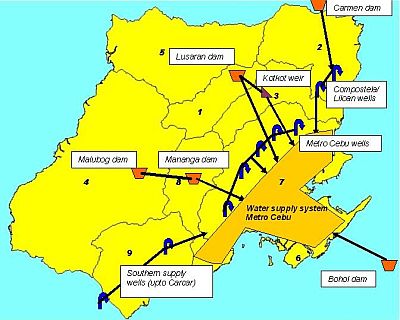Quick scan water balance for Central Cebu
Introduction
Cebu is an island located in the centre of the Philippines. Over the last two decades, it has been recognized that Metro Cebu is facing an impending water supply crisis. Social and economic developments in Cebu Province increasingly depend on the water supply. This, together with the rapid industrialisation, the dense population and the fact that Cebu is a small island, resulted in the present concern. Traditionally, the public water supply of Metro Cebu heavily relied on the underground aquifers. Because of salt-water intrusion the present extraction rates are not considered sustainable. The tapping of surface water from other watershed areas is presently considered as extra resources in view of the high annual rainfall received by other parts of the island. The aim of the Water REMIND project is to provide an integrated approach that addresses the above described problems. The Quick-scan described in this thesis can be seen as a preliminary study for the Water REMIND project.
Research
Two research objectives are defined for the Quick-scan: The development of a water balance model for the Central Cebu area. The identification, analysis and evaluation of alternative water resources to supply Metro Cebu. The water balance model for Central Cebu is developed by applying the model concepts of the RIBASIM software package. This water balance model, together with supporting cost calculations and other general information, is applicated as an instrument to analyse and evaluate the water resources.

Outcomes
For this study, it is found that sufficient data is available to develop a water balance model for the three central watersheds of Central Cebu. For the other six coastal watersheds additional data is desired. For all nine watersheds the reliability of the water balance model can be improved by increasing the quality of the available rainfall, evaporation, discharge and groundwater level data. The model application should be seen as a first investigation into the possibilities and problems to improve the water supply situation of Central Cebu. Three strategies are composed based on a screening of 13 possible measures:
Strategy 1: Infrastructure measures in ground water (well fields) and surface water (dams and weirs).
Strategy 2: Demand reduction with measures in surface water infrastructure.
Strategy 3: Demand reduction with measures in ground water infrastructure.
Strategy 1 turned out to be the least favourable strategy, as it is negatively assessed for most of the indicators. Strategy 2 appears to result in the lowest unit water costs, while strategy 3 scores positively for the indicators regarding feasibility.
As the ability of actual implementation is crucial to a successful future situation, strategy 3 is chosen as the most favourable. The sensitivity analysis, which has been carried out to the preferred strategy under more extreme external conditions, showed the robustness of the chosen strategy.